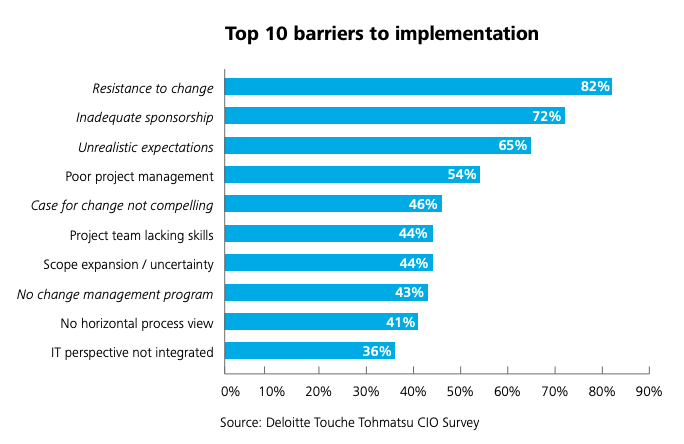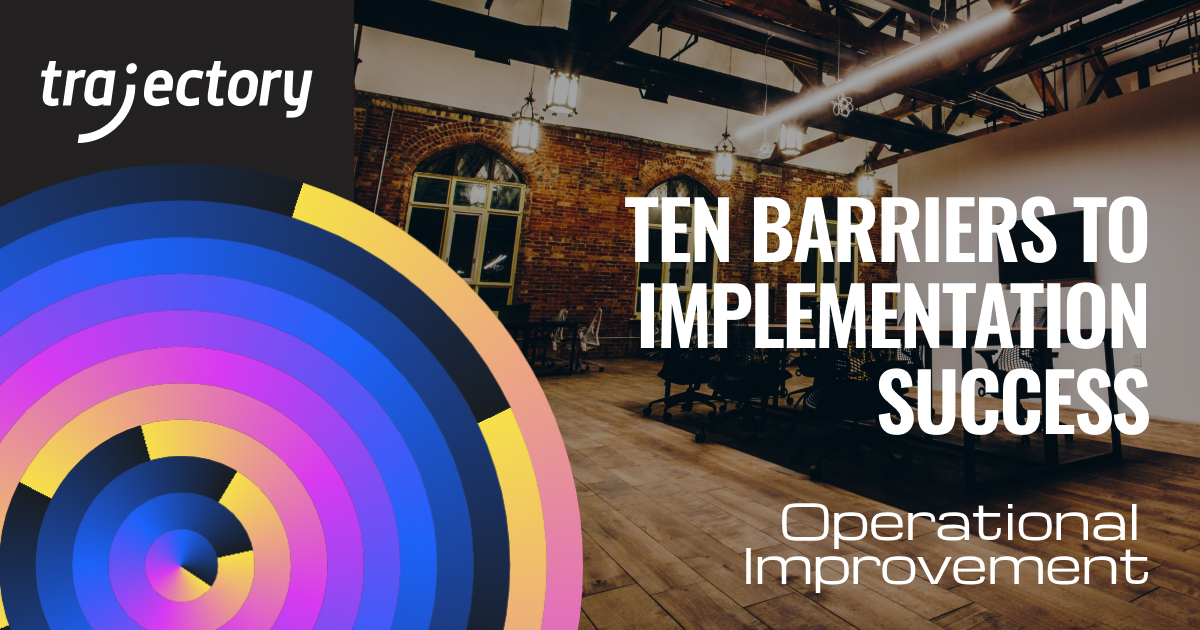Often a prerequisite for operational improvement is the requirement for technology transformation. When embarking on a technology implementation journey, there are many factors to consider. At Trajectory, as specialists with over 15 years of experience in technology ecosystem implementation, we are often asked what strategies make for effective technology implementation. This question can be answered by outlining how to mitigate the 10 common barriers to implementation, as identified by a Deloitte CIO Survey below:

10 Barriers to Implementation Success
Let’s explore each of these barriers and how we mitigate them to achieve effective technology implementation.
Potential Barriers
Mitigation Strategies
Unrealistic Expectations – Starting off an implementation with a realistic perspective regarding an appropriate project timeline, budget and the resources that will be required to complete the implementation successfully is key. Implementations are classically known for going over-budget, over-time and for over-working the implementation team members.
Weak Project Management – The importance of having a dedicated resource responsible for monitoring project timelines, activities, and budget can not be underestimated.
Effective Project Management – A detailed project plan will outline the theoretical execution and timing, but monitoring progress, budget utilization, tracking task allocation and deadline adherence on a regular basis are critical.
Case for Change is not Compelling – If the business requirements for change is not palatable to end-users, the chance of implementation failure and results in low user adoption – deadly to any change project.
Thoughtful Case for Change – It is important to clearly articulate the ‘whys’ of the change and the benefits of making the change.
Project Team Lacking Proper Skillset – It’s one thing to set an implementation goal, but you must ensure the resources assigned to attaining that goal are equipped to do so.
Build Appropriate Project Team – Team should consist of:
- Project sponsor – Executive-level who is willing to set the overall vision and has the decision making power to ensure it’s achieved.
- Subject Matter Experts – front-line specialists who can participate in requirements gathering and system testing and validation.
- Project Manager – someone capable of working with cross-disciplinary teams to ensure tasks are completed, timelines are met and budgets are maintained throughout.
Scope Expansion/Uncertainty – Scope change is highly likely during a technology implementation as new requirements often uncover themselves when dissecting how you want your business to operate in new ways.
Scope Prioritization – The best way to manage scope creep is to undertake a detailed blueprinting exercise before starting configuration. Most (if not all) business requirements are captured and solutioned for. This list is then actively managed, prioritized and phased if there are budget or time constraints, with ‘must-have’ requirements are in the initial phase and the ‘nice-to-have’ requirements included later.
Lack of Change Management – An often-overlooked element, a proactive plan starting early in the implementation cycle will address things that a resistor adopts to not accept the change.
Change Management Taken Seriously – Assign someone with experience as Champion for the steps in effective Change Management:
- Reinforce the case for change
- Facilitate ongoing communication
- Manage specific resistance
- Document and share progress
- Provide reinforcement
No Horizontal View – Perceiving the solution as separate from overall business processes can lead to implementation failure. Often, businesses focus too tightly on the mechanics of the solution within the software platforms and overlook the implications on business operations.
See the Overall Business Processes – Before the blueprinting process it’s helpful for all business owners to map all desired end-to-end business processes. The technology elements can then be worked into the workflows to determine fit and support of the overall operation.
IT Perspective Not Integrated – Currently we are seeing a trend of companies implementing cloud-based ecosystems, consisting of several solutions linked together to automate and manage daily operations across all departments. The goal should be to consolidate information and functionality, which is a departure from the historic siloed IT mindset.
Integrated Ecosystem View – Clearly communicating the requirements and benefits of a unified ecosystem to all key stakeholders, including the IT team generates ownership and a 360-degree viewpoint of the project.
Wrap-Up
Trajectory has mitigated these and other barriers to success through hundreds of technology implementations. We coach clients on realistic expectation setting, change management approach, constructing their project teams, and guiding them with our comprehensive implementation methodology, including: business process design, detailed blueprinting workshops, thorough solution build, testing, training and Go-Live. Through these mitigation steps, we collectively achieve true operational improvement.


Alex Olano
CEO, Managing Partner
Throughout his 18-year career at Trajectory, Alex’s role has ranged from managing teams and projects to running the professional services organization, and mentoring Trajectory’s growing number of Consultants. Currently, he leads the Trajectory Team and invests his time ensuring Private Equity avoids key technology risks during their transactions. Alex understands technology is simply the means for achieving business goals. He has guided Trajectory’s organization to form its own version of Operational Improvement, which combines industry and business acumen with highly effective technology implementation capabilities. Prior to joining Trajectory Group, Alex spent 10 years in business consulting, systems advisory, and SAP implementations with IBM Global Services and Accenture.




